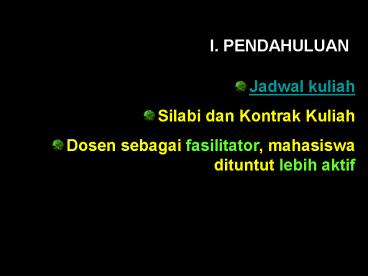I. PENDAHULUAN PowerPoint PPT Presentation
1 / 44
Title: I. PENDAHULUAN
1
I. PENDAHULUAN
- Jadwal kuliah
- Silabi dan Kontrak Kuliah
- Dosen sebagai fasilitator, mahasiswa dituntut
lebih aktif
2
- Penilaian (SK Rektor UNS No. 459/H27/PP/2007
tentang Peraturan Kredit Semester Perbaikan
Peraturan Sistem Kredit Semester)
NA rata-rata (2KD1 1Prakt) (2KD2
1Prakt) (2KD3 1Prakt) (2KD4 1 Prakt)
A 80 C 60 69 B 70 - 79 D 59 - 50 E
49 TL
3
Mikrobia ? organisme mikroskopis kelompok
yg sangat besar dan beragam (biodiversitas
sangat tinggi) sel tunggal, kelompok
sel, non seluler (virus)
4
Microbiology
- The study of of organisms too small to be seen
without magnification - bacteria
- viruses
- fungi
- protozoa
- algae
5
Branches of study within microbiology
- Immunology
- Public health microbiology epidemiology
- Food, dairy and aquatic microbiology
- Biotechnology
- Genetic engineering recombinant DNA technology
6
Berbagai Koloni Mikrobia (colony forming unit,
cfu)
7
BAKTERI
8
bintil akar
9
(No Transcript)
10
(No Transcript)
11
(No Transcript)
12
FUNGI (JAMUR)
13
Rhizopogon cokeri Amanita muscaria
truffle mushroom
14
Variable Mycorrhizal Infection
15
Gigasporum gigantea
16
Arbuscular Mycorrhizae
Extramatrical Hypha
Arbuscule
Spores
Vesicle
17
PROTOZOA
18
(No Transcript)
19
(No Transcript)
20
(No Transcript)
21
ALGAE
22
Eutrofikasi / blooming algae
23
(No Transcript)
24
Microbes are involved in
- nutrient production energy flow
- decomposition
- production of foods, drugs vaccines
- bioremediation
- causing disease
25
Mikrobiologi Industri
26
Impact of pathogens
- Nearly 2,000 different microbes cause diseases
- 10 B infections/year worldwide
- 13 M deaths from infections/year worldwide
27
Tipe sel mikrobia
28
Characteristics of microbes
29
ukuran
30
Antonie van Leeuwenhoek
- First to observe living microbes
- his single-lens magnified up to 300X
(1632-1723)
31
(No Transcript)
32
Scientific Method
- Form a hypothesis - a tentative explanation that
can be supported or refuted by observation
experimentation - A lengthy process of experimentation, analysis
testing either supports or refutes the hypothesis - Results must be published repeated by other
investigators.
33
- If hypothesis is supported by a growing body of
evidence survives rigorous scrutiny, it moves
to the next level of confidence - it becomes a
theory - Evidence of a theory is so compelling that the
next level of confidence is reached - it becomes
a Law or principle
34
Spontaneous generation
- Early belief that some forms of life could arise
from vital forces present in nonliving or
decomposing matter. - (flies from manure, etc)
35
Louis Pasteur
- Showed microbes caused fermentation
- Disproved spontaneous generation of m.o.
- Developed aseptic techniques.
- Developed a rabies vaccine.
(1822-1895)
36
Aseptic technique methods for maintaining steril
culture media and other steril objects free from
microbial contamination during manipulation
Culture medium an aqueous solution of various
nutrients suitable for the growth of
m.o Enrichment culture methods for isolating
m.o. from nature using specific culture and
incubation condition
37
Robert Koch
- Established a sequence of experimental steps to
show that a specific m.o. causes a particular
disease. - Developed pure culture methods.
- Identified cause of anthrax, TB, cholera.
(1843-1910)
38
Germ theory of disease
- Many diseases are caused by the growth of
microbes in the body and not by sins, bad
character, or poverty, etc.
39
Taxonomy - system for organizing, classifying
naming living things
- Domain Archaea, Bacteria Eukarya
- Kingdom 5 (Monera, Protista, Fungi, Plantae,
Animalia) - Phylum or Division
- Class
- Order
- Family
- Genus
- species
40
3 domains
- Eubacteria true bacteria, peptidoglycan
- Archaea odd bacteria that live in extreme
environments, high salt, heat, etc - Eukarya have a nucleus, organelles
41
Kingdom Monera
42
(No Transcript)
43
Naming micoorganisms
- Binomial (scientific) nomenclature
- Gives each microbe 2 names
- Genus - noun, always capitalized
- species - adjective, lowercase
- Both italicized or underlined
- Staphylococcus aureus (S. aureus)
- Bacillus subtilis (B. subtilis)
- Escherichia coli (E. coli)
44
Evolution living things change gradually over
millions of years
- Changes favoring survival are retained less
beneficial changes are lost. - All new species originate from preexisting
species. - Closely related organism have similar features
because they evolved from common ancestral forms. - Evolution usually progresses toward greater
complexity.

